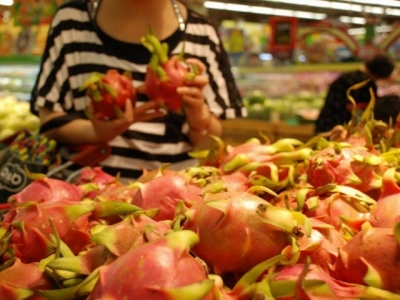Vietnamese fruit could face trade barriers in Chinese market

China has become more fastidious about fruit imports, setting high requirements similar to those applied by the US and Australia.
Vietnam has many kinds of tropical fruits
Doan Xuan Hoa from the Ministry of Agriculture and Rural Development has warned that Vietnam’s farm produce will have to overcome big barriers to enter the Chinese market.
China, which plans to control growing areas and fruit packaging processing, may manage imports in sequence to more easily track down the origin of products.
If China tightens control over imports across border gates, Vietnam will only be able to export eight kinds of fruits (dragon fruit, melon, rambutan, mango, litchi, longan, banana and jackfruit) through official channels. The exports of other products will depend on negotiations of the two governments.
The strict requirements would lead to import restrictions. China is one of the largest export markets for Vietnam’s fruits.
Vietnam is able to satisfy quarantine requirements set by 40 importing countries, including choosy ones such as the US, New Zealand, Japan, South Korea, Australia, Chile, Argentina and Brazil.
Vietnam is able to satisfy quarantine requirements set by 40 importing countries, including choosy ones such as the US, New Zealand, Japan, South Korea, Australia, Chile, Argentina and Brazil.
However, Vietnam’s fruit exports to the US, Japan, South Korea and Australia just account for only 10 percent of total export turnover, while the other 75 percent is from the Chinese market.
The problem for Vietnam’s fruits is that the majority of products are exported across border gates, while the export volume and product prices always fluctuate, leading to unstable incomes for farmers.
On 2018 pre-Tet days, 1,200 container vehicles and trucks carrying farm produce queued up at the border gate in Lang Son province, waiting for their turn to enter China.
However, with the low customs clearance capacity, only 800 trucks can cross the border every day. As a result, fruits rot because of late delivery, causing merchants to take losses.
With the ASEAN-China Free Trade Agreement (FTA), Vietnam’s fruit exports to China will enjoy the zero percent export tariff.
However, the management agencies of the two countries will still have to fulfill procedures for registration and risk assessment.
China will define the customs clearance gates, considered a barrier to protect domestic production.
Vietnam has many kinds of tropical fruits, but exports to the world market remain modest.
Nguyen Huu Tri, director of the Tri Viet Agricultural Food Trading Production Company, said foreigners favor natural, safe and non-toxic products that retain their typical flavors. If Vietnam can provide the products, it will succeed.
Có thể bạn quan tâm
 Vegetable prices plunge in northern and central regions
Vegetable prices plunge in northern and central regions After waking up at 5am, Nguyễn Thị Oanh, a farmer in Hà Nội’s Ba Vì District, headed to the field to cut cabbages and carried them to the local market for sale.
 VN, Netherlands to boost agricultural co-operation
VN, Netherlands to boost agricultural co-operation Dutch businesses have shown interest in Việt Nam’s agriculture sector in general and the vegetable processing industry in particular as the industry has grown
 Seminar talks fruit, veg exports
Seminar talks fruit, veg exports Việt Nam’s fruit and vegetable exports are expected to top US$4.5 billion by 2020, with fruits accounting for $3.6 billion